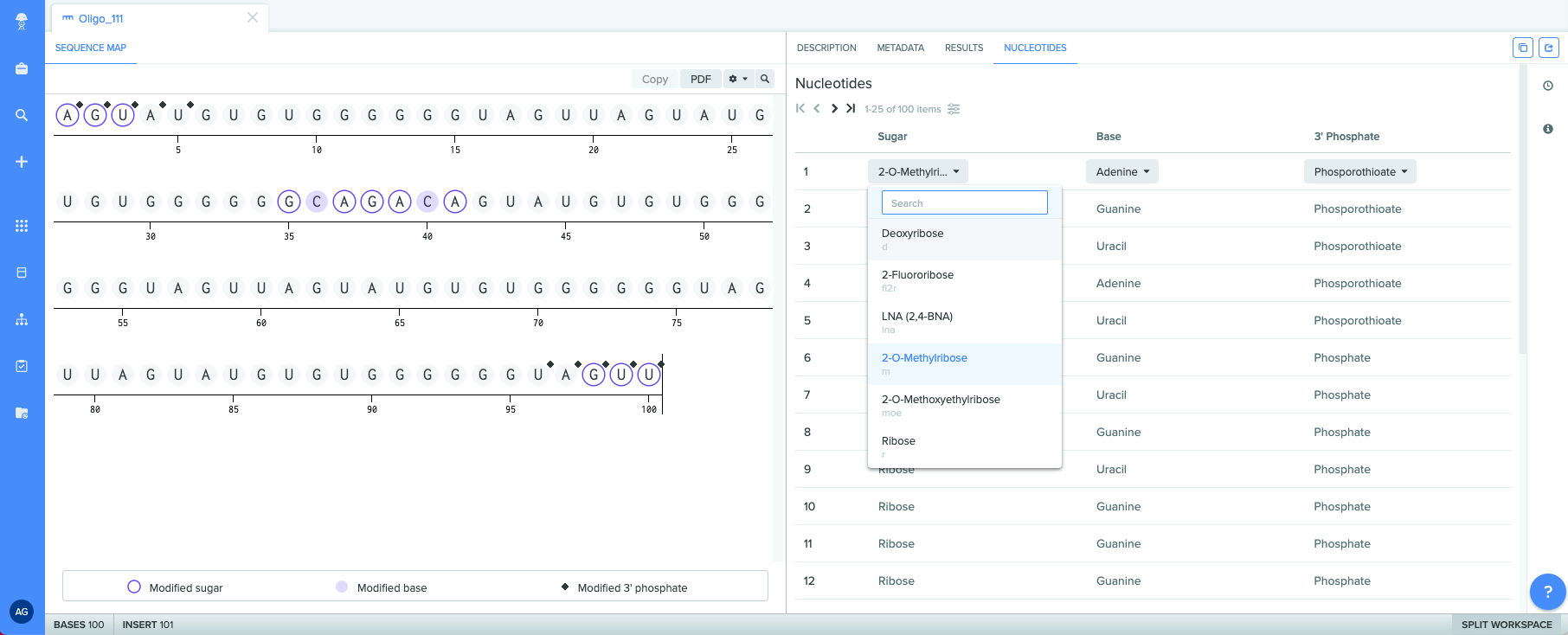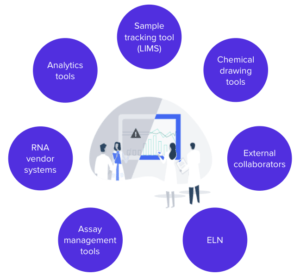Benchling Introduces Integrated Functionalities for RNA Therapeutics
Benchling is excited to announce the rollout of new capabilities designed to support RNA therapeutics. RNA represents a promising new modality for the delivery of treatments targeting diseases that have been difficult to address with other therapeutic approaches. But the complexity of RNA molecules, especially tracking the chemical modifications to improve stability and performance, has posed an informatics and collaboration challenge for R&D scientists. With Benchling's solution, teams can now create, design, visualize, and register chemically modified oligonucleotides — including microRNA (miRNA) and small interfering RNA (siRNA) within the class of RNA interference (RNAi), small activating RNA (saRNA), antisense oligonucleotides (ASOs), and aptamers — within the same platform. Benchling’s unified informatics solution for the specific needs of working with RNA helps bring RNA-based therapies to patients faster and more efficiently than ever before.

Challenges and Opportunities at the Intersection of Biology and Chemistry
RNA therapeutics transcend the traditional design paradigm of “one-drug, one-target,” to flexibly and iteratively target diseases in ways that were previously considered impossible for antibody-, small molecule-, and peptide-based approaches. Significant progress has been made through innovative applications of both biology and chemistry; particularly the introduction of non-natural oligonucleotides and other chemical modifications. These new applications offer scientists unprecedented therapeutic performance and tunability, leading to tremendous gains in stability, potency, durability, and target precision. Now the industry’s focus has shifted to scaling this approach, in order to address increasingly broader sets of targets. As a result, the pipeline for RNA therapeutics is rapidly expanding, encouraged by the market success of treatments such as siRNA to treat amyloidosis, and mRNA vaccines for SARS-CoV-2.

At the same time, the inherently hybrid nature of RNA therapeutics has hindered existing software solutions’ ability to support effective R&D in this area. Legacy scientific informatics systems are optimized for either chemistry or biology, but not both. Software solutions that focus more heavily on chemistry-based workflows stymie researchers working with large, complex biomolecules. Most frequently, scientists must design and manage oligos in spreadsheets and across disconnected legacy systems. Furthermore, this decentralized informatics model has produced a range of different nomenclatures which researchers and vendors use to denote these chemical modifications. These challenges have curtailed R&D growth in this space, extending timelines and increasing risk of human error. Just as RNA therapeutics represent a newly integrated technological field, they require integrated data management and collaboration software to drive successful discovery, testing, and development.
Holistic Analysis of Oligonucleotide Structure and Function
To solve these challenges, Benchling has developed functionality focused on three core capabilities. These capabilities are designed to support the collaborative, insight-driven, and high data quality dependent scientific work performed in Benchling, including:
Design and visualization tools
Benchling’s proprietary Hierarchical Editing Language for Macromolecules (HELM) editor includes design and visualization capabilities optimized for oligo-level editing and modification, even providing the ability to transition between atomic-, sequence-, and entity-level representations. Benchling makes working with the complete oligo — base + sugar + phosphate — easier and quicker, eliminating the need to create RNA from the atomic level up. Experimental information is also contextualized within these visualizations, yielding more useful insights on each chemical modification’s impact on the oligo’s structure and function.
Data model and standardization
Benchling’s data model and standardization tools centralize the experimental context of oligo modifications. Captured data appears within structured results tables, which ensure high data integrity. Benchling’s Monomer Library makes it easy for researchers to leverage and customize the most common base monomers. The embedded HELM and IDT Syntax notations standardize complex biomolecule representation. And the platform can register or create oligos with uniqueness checks, expanding the Library while keeping the research database organized.
Collaborative workflows
Benchling is configurable for an unlimited number of users, all of whom can share and collaborate iteratively across biological and chemistry workflows. Advanced search functionality, including sorting and filtering options, makes it easy to find both natural and chemically modified sequences. This improves transparency across teams and provides ready access to all your team’s sequences and related data with just a few clicks. What’s more, teams can automatically centralize oligo-relevant data such as inventory location, pertinent experiments, sequence history, and associated analytical results — improving data traceability and making it easy to track the experimental history of each oligo sample.
“Our scientists have been eager to find an informatics tool that could help us design and display our modified oligonucleotides easily. Benchling offers an extensive and easy-to-use tool that supports our work with modified RNA across our multidisciplinary teams.”
– Alexandre Debacker, Research Scientist, MiNA Therapeutics
Benchling’s new RNA therapeutics capabilities are designed to integrate modified oligonucleotides into Benchling’s flexible and interconnected data model. Scientists can work on miRNA, siRNA, RNAi, ASO, or aptamers as complete hybrid molecules, standardize on syntax, centralize experimental results, and collaborate with teammates more seamlessly, all within a single platform. We look forward to seeing how life sciences R&D organizations leverage these functionalities to bring cutting-edge RNA therapeutics to market faster.
Powering breakthroughs for over 1,300 biotechnology companies, from startups to Fortune 500s



